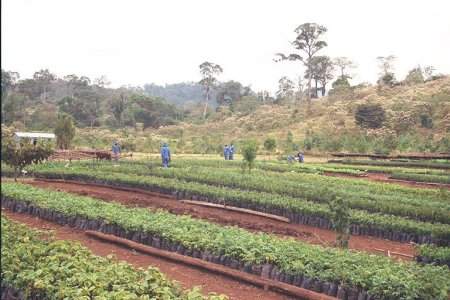When I was asked to give the welcome words at the workshop on trans-boundary conservation yesterday, organised by the German Federal Agency for Nature Conservation (BfN), Korean National Park Service and the IUCN World Commission on Protected Areas Transboundary Conservation Specialist Group, I thought back to experiences in my own career, as I have been involved in trans-boundary conservation efforts in different parts of the world.
I started my career in Botswana in the early nineteen eighties, as a District Officer. I worked for the Ministry of Local Government and Lands, and one of the new ideas discussed for the Region at the time was to create a protected area straddling the borders of Zimbabwe, Mozambique and South Africa. This trans-frontier conservation area has since been established, and IUCN is working in the Great Limpopo Trans-frontier Conservation Area with assistance from the Italian Government.
In 1989, I joined IUCN in East Africa, and one of the projects that I was responsible for was the Mount Elgon forest conservation project in Uganda.
In those days, we talked about joining this project in Uganda with conservation efforts on the Kenyan side of the mountain, and had several informal discussions about cross-border measures. I believe that a trans-boundary project has subsequently been implemented by the East African Community.
My next posting was in Vietnam, where I was involved in the development of a corridor of protected areas along the border between Vietnam and Lao PDR, protecting the critical biodiversity of the Annamite Mountains, and when I worked at the IUCN Regional Office for Asia in Bangkok, I was partially responsible for the development of the Hindu Kush – Karakorum – Himalayatrans-boundary project with assistance from the Italian Government.
Now, I am responsible for the IUCN programme in Europe, and we are involved in several key trans-boundary conservation initiative in Southeastern and Eastern Europe. I would like to briefly mention three:
- The Green Belt of Europe is a more than 12,500km long ecological corridor from the Barentz Sea in the north to the Black Sea in the south. Originally envisaged as the ecological restoration of the former division between East and West Europe, it has transformed into a multi-national, trans-boundary initiative which brings together Members and partners along a common purpose of ecosystem management and restoration. I learned during the discussions at the workshop, that IUCN is expected to play a stronger role in the initiative, especially by lobbying at the European level for recognition and support of the activities along the green Belt. I will explore ways and means to do this more efficiently.
- The Dinaric Arc Initiative is a broad framework of collaboration between several organisations and the countries in the Dinaric mountains, which aims to put in place new specific actions aiming at the preservation of the wealth and integrity of the Dinaric Arc eco-region through the establishment of networks of protected areas and ecological corridors, and support to initiatives for the conservation of its biological diversity and the sustainable management of its resources. My technical background is in karst hydrology, and the Dinaric Arc is mainly comprised of limestone. I was in Slovenia recently, and visited Postojna Cave – This is just one of the many important sites in the karst landscape in the Dinaric Arc. You will notice the water supply sign – karst aquifers are critically important for water management!
- The Caucasus Cooperation Centre is the IUCN Office in Tbilisi. It aims to make nature conservation in the southern Caucasus more effective by providing a range of services to all interested and engaged actors in the field. Our Members and partners in the Caucasus have asked us to focus on two priority trans-programme areas: Biodiversity Conservation and Natural Resources Management. I have visited Tbilisi several times, but have not yet had the opportunity to visit nature in the southern Caucasus. This is on the cards for early 2014!
This short history of my personal experiences is why I felt quite comfortable to give a welcome word at a protected area meeting.



Hans – I was humbled by your account of what is happening accross a number of countries worldwide as I reflect on our situation in England with its complexity of landscapes and our endeavours to embrace our new Biodiversity 2020 strategy with “more, bigger and better”. We have recently gained support from government to develop 12 Nature Improvement Areas – our response to conservation across borders perhaps. Natural England is supporting a complex number of partners to deliver these joined up, landscape scale projects that hopefully will secure more intact ecosystem services. Let’s hope we can show that it can be done albeit at what in your terms would seem very small scale at c.50,000 hectares each.
Dear Lucy
All efforts help, and the total will hopefully be more than the sum of the individual activites. I will make sure that my colleagues know about this initiative by Natural England, so we can facilitate exchange of information and learn from your experience.
Thanks a lot for your response
Hans